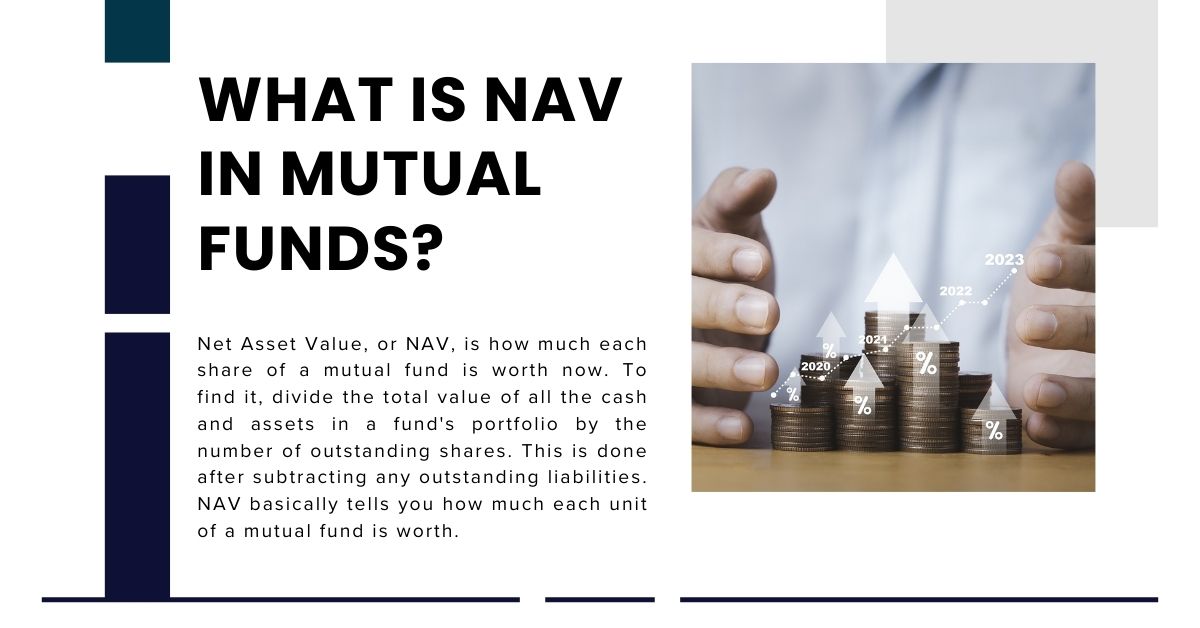Mutual funds are a popular way to invest because they are professionally managed and help buyers spread their money around. You can choose from thousands of different ways to invest just by using mutual funds. That being said, it’s important to know some terms related to mutual funds before you buy.
Net Asset Value, or NAV, is a key idea that helps people figure out how much their investments are worth. Let’s learn more about what Net Asset Value (NAV) of a mutual fund means, how it’s measured, and what it means when you buy or sell a mutual fund.
What is NAV in Mutual Funds?

Net Asset Value, or NAV, is how much each share of a mutual fund is worth now. To find it, divide the total value of all the cash and assets in a fund’s portfolio by the number of outstanding shares. This is done after subtracting any outstanding liabilities. NAV basically tells you how much each unit of a mutual fund is worth.
It’s like the price tag on a share of an investment fund. The NAV will go up if the value of the assets the fund invests in goes up. If, on the other hand, those assets lose value, the NAV will go down. This daily change in NAV shows how well the fund’s investments are doing.
What is the Net Asset Value Formula?
The formula for Net Asset Value (NAV) is:
NAV = (Total Assets - Total Liabilities) / Number of Outstanding Shares
- Total Assets: This is the value of all the stocks, bonds, and other assets, as well as the cash that the mutual fund holds.
- Total Liabilities: To sum up, the fund’s liabilities are its debts, which include fees and costs.
- Total Number of Outstanding Shares: This shows how many mutual fund shares are out there right now.
You can find out how much each share in the mutual fund is worth right now by finding the NAV. Investors need this knowledge in order to keep track of how their investments are doing and make smart choices.
How Does NAV Work?
NAV gives you a daily picture of how much a mutual fund is worth. Every business day, the fund’s portfolio is valued, and the NAV changes whenever the value of its stocks changes. One example is that the NAV will go up if the fund buys stocks that go up in value. If, on the other hand, the fund’s holdings lose value, the NAV will go down.
Investors can use the NAV to find out how much their mutual fund shares are worth. They can figure out how much their investment is worth by multiplying the number of shares they own by the NAV.
This information is very important for keeping track of success, making investment choices, and knowing how changes in the market affect their portfolio.
Role of NAV in the Performance of a Fund
When looking at how well a mutual fund is doing, NAV is very important. To see how well the fund’s purchases have done over time, we use this number as a standard. If the NAV keeps going up, it means that the fund’s assets are growing and owners are getting money back. On the other hand, a falling NAV means that the investments in the fund are losing value.
However, it’s important to remember that NAV is only one part of judging how well a fund did. Some other important factors are the fund’s investment plan, expense ratio, and the experience of the manager. Investors can make smart choices about their investments by looking at these things along with the NAV.
NAV Allotment for Different Investment Types
The NAV allocation for various types of investments can change based on the financial goals and strategy of the fund in question. Here are some broad rules, though:
- Equity Funds: These funds primarily invest in stocks. They typically have higher NAV fluctuations due to the volatility of the stock market. Investors with a higher risk tolerance and a longer investment horizon are often drawn to equity funds.
- Debt Funds: These funds invest in fixed-income securities like bonds. They generally have lower NAV fluctuations compared to equity funds, making them suitable for investors seeking relatively stable returns and lower risk.
- Hybrid Funds: These funds invest in a combination of stocks and bonds. They offer a balance of risk and return, making them suitable for investors with moderate risk tolerance.
- Money Market Funds: These funds invest in short-term, highly liquid securities. They offer relatively stable NAVs and are often used as a cash equivalent.
It’s important to keep in mind that the NAV distribution for each type of investment can change a lot depending on the investments the fund makes and the state of the market. Before deciding to spend, people should read the fund’s prospectus carefully to understand how it makes investments and how risky it is.
What Affects the NAV Of A Mutual Fund?
There are several things that can change a mutual fund’s NAV:
- Market fluctuations: Significant changes in the values of the base assets, such as stocks, bonds, or commodities, can have an impact on the NAV. The NAV is expected to go up if the market goes up and down if the market goes up.
- Investment strategy of the fund: The assets a fund purchases and the way it spends money can alter its NAV. For example, the NAV of a fund that invests in risky stocks may change more quickly than the NAV of a fund that invests in safer bonds.
- Fund expenses: As time goes on, the NAV may go down due to management fees and operating costs that come with running the fund.
- Dividend distributions: When a fund gives dividends to its owners, the NAV goes down by the dividend amount.
- Capital gains distributions: If a fund sells assets for a profit, it may give capital gains to owners. This can have an effect on the NAV as well.
These things can affect a mutual fund’s NAV in a lot of different ways. When investors look at a fund’s success and decide what to invest in, they should carefully think about these factors.
What Are the Trading Timelines for NAV?
Most of the time, NAV is found at the end of every trading day. This means that the NAV you see each day shows how much the fund’s holdings were worth when the market closed that day. Most of the time, investors can get the most up-to-date NAV information from the fund’s website or their trading account.
Keep in mind that the NAV is determined at the end of the trading day, but investors can usually buy or sell mutual fund shares at any time during the trading day. But if the price of the fund has changed since the last NAV estimate, the price at which they buy or sell may be different from the NAV.
What Does NAV Mean in Finance?
Net Asset Value, or NAV, is a very important term in finance, especially when talking about mutual funds. It shows how much a mutual fund share is worth. For the most part, the NAV tells you how much a piece of the fund is worth.
To find it, divide the total value of all the assets the fund owns (minus any debts) by the number of shares that are still available. NAV is a daily measure of how well the fund is doing, showing how the values of its investments have changed.
Where Do You Find the Net Asset Value per Share of a Mutual Fund?
Some places where you can find a mutual fund’s Net Asset Value (NAV) per share are:
- Fund’s Website: The websites of most mutual fund companies show NAV information in real time or very close to real time. This kind of information is usually on the fund’s home page or in the “performance” part.
- Brokerage Account: If you buy mutual funds through a brokerage company, the NAV of the funds you own will usually be shown on your account statement or online platform.
- Financial News Websites: A lot of these sites and apps give NAV information for a lot of different mutual funds. A lot of the time, you can search for the fund’s name or ticker number to get its NAV.
- Mutual Fund Research Websites: Websites that focus on mutual fund research and analysis often have a lot of information about how well funds are doing, such as their NAV.
Keep in mind that NAV can change during the business day. More often than not, the fund’s website or your brokerage account will have the most correct and up-to-date information.
Is a High NAV Good or Bad?
A high NAV doesn’t always mean that a purchase in a mutual fund is good or bad. What matters most is the fund’s overall performance over time, which is typically evident in its return. A high NAV could just mean that the fund has invested in assets that have gone up in value, but it doesn’t mean that the fund will do well in the future.
A high NAV is basically just a picture of how much a fund is worth right now. To find out if it’s a good investment, you need to look at how it’s done over time and think about other important factors.
What is a Good NAV for a Mutual Fund?
For a mutual fund, there is no one “good” NAV. The NAV is just a snapshot of how much each share of the fund is worth right now. What matters most is the fund’s overall performance over time, which is typically evident in its return.
A high NAV could mean that the investments in the fund have done well, but it doesn’t mean that they will do well in the future. More important things to think about are the fund’s expense ratio, investment plan, and management team.
You shouldn’t just look at the NAV. You should also look at the fund’s past results, risk profile, and how it stacks up against its benchmark index. You’ll have a better idea of whether the fund fits your financial goals after reading this.
Does NAV Change Daily?
Yes, NAV (Net Asset Value) changes every day. This is because the assets that a mutual fund holds can change worth during the trading day. If the market goes up, the stocks in the fund may become worth more, which could cause the NAV to go up. If the market goes down, on the other hand, the NAV may go down.
The NAV can change a lot every day depending on things like market volatility, the economy, and the fund’s investment plan. To keep track of how their investments are doing and make smart choices, investors need to keep an eye on how the NAV changes.
Is NAV Same as Book Value (BV)?
In this case, NAV and BV (Book Value) do not mean the same thing. Both terms refer to how much a company’s assets are worth, but they are calculated in different ways.
Most of the time, NAV is used to talk about mutual funds. The value of a fund share is found by dividing the total value of the fund’s assets minus its debts by the number of shares that are still available. NAV is a daily measure of how well a fund is doing.
When you take a company’s total liabilities away from its total assets, you get its book value, which is a measure of its net worth. It’s often used to figure out how much a company’s stock is really worth. The book value of an object may not always be the same as its market value because it depends on things like how it was valued and how it was recorded.

